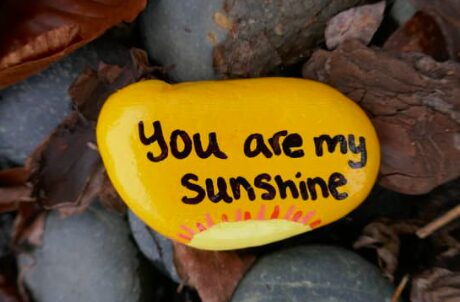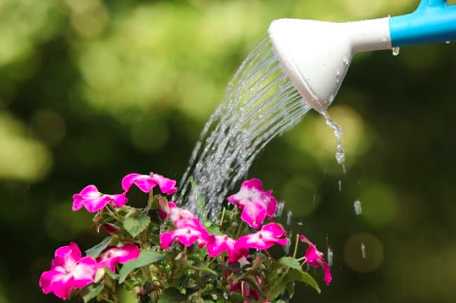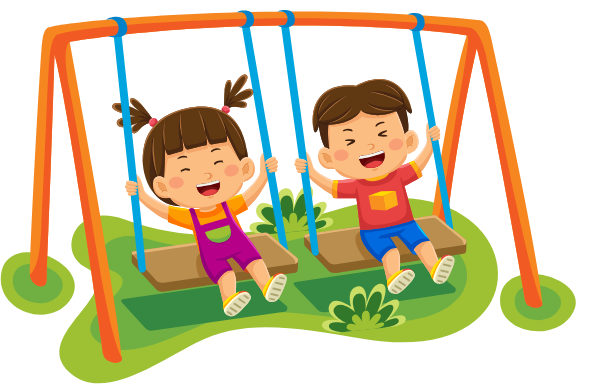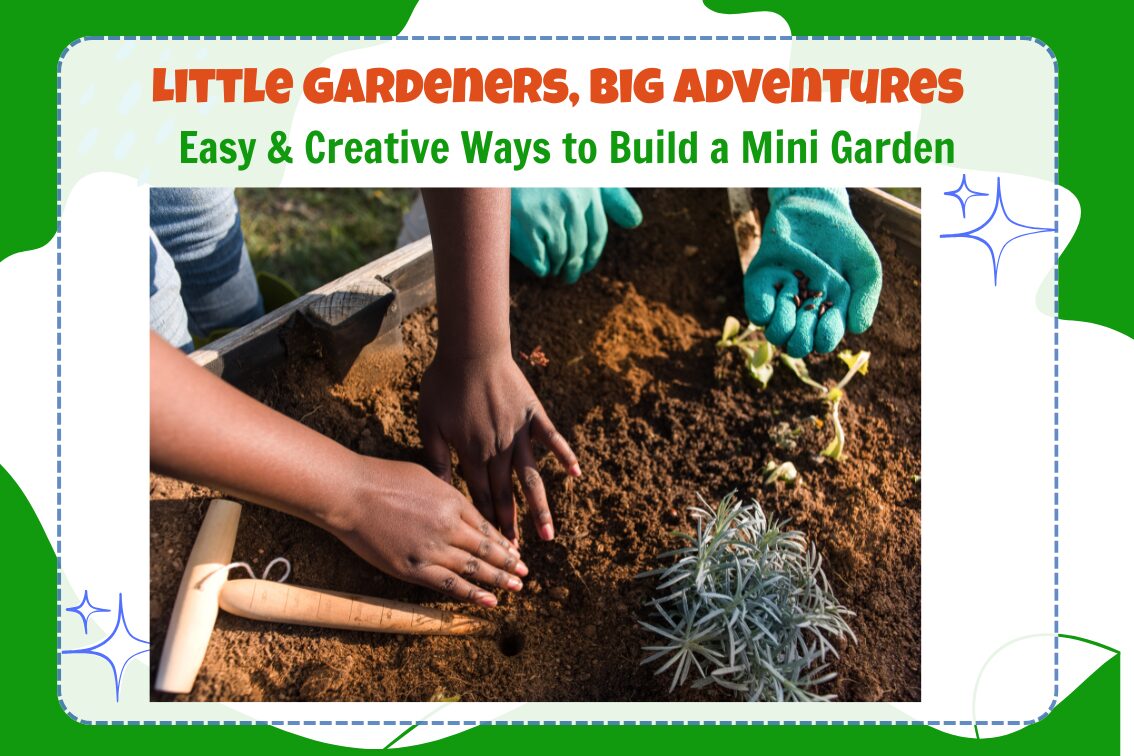*This post may contain affiliate links for which I earn commissions.*
A playhouse is already a magical place for kids. It’s where they act out stories, pretend to be princesses, pirates, or superheroes, and just generally let their imaginations run wild.
But why not make it even more fun by helping your kids grow their own garden around their house?
Adding a little garden can give the entire area some color and charm, encourage kids to spend more time outdoors, and teach kids about plants and wildlife.
It also lets kids take pride in caring for their own special “bit of earth … to plant seeds in—to make things grow—to see them come alive.” [That’s a quote from The Secret Garden by Frances Hodson Burnett. If you’re not familiar with, please go get a copy and begin reading it with your children immediately after finishing this post.]
In this post, you’ll learn some simple and fun steps to create a charming garden [whether secret or not] around your child’s playhouse — one that’s sure to become a little backyard paradise they’ll love.
Planning Your Playhouse Garden
It’s a bit amusing to me that I’m giving gardening advice, because I started my first [small] garden less than three years ago, and this will (hopefully!) be the first summer that I actually get more than two usable tomatoes out of it.
(My biggist gardening problem is that I’m too much of an optimistic. I’d shoved way too many tomato plants into way too little space — and then threw in some cilantro and basil seeds for good measure. None of the poor things could breathe.
Also, along similar lines, was soil was not deep enough. I was so excited about the growth I could see that I sort of forgot that plants also grow down and that a “raised bed” needs to actually be raised more than two inches of soil.)
But hey, I actually do have a garden, so I do know a few things to get you started, at least.
First of all, before you started shoveling up your background or grabbing all the prettiest plants you see at Pike Nursery, you need figure out if your future gardening area would be described as full sun, partial sun, or shade.
Also, what’s the ground like? Can you actually dig up that area without seriously injuring yourself? If the ground around your playhouse is rocky and/or full of roots, you want to set up a raised bed or arrange potted plants in that area.
Next, think about the vibe you want for the garden. Do you want it to feel like a magical fairy garden, a place to grow your own herbs, fruits, and vegetables,, or a space that attracts butterflies and bees? Picking a theme can make it easier (and more fun) to choose plants and decorations.
As you’re planning your garden, make sure you get your kids involved. Let them help pick out flowers or veggies (hint: make sure you plant something your family will actually eat), choose colors they like best, and even come up with fun ideas like painting garden rocks or making garden signs. When kids help plan the garden, they’re much more excited to help take care of it — and proud to show it off to friends and family. And hey, why should you do all the work?
Choosing Child-Friendly Plants

When picking plants for your garden, it’s all about keeping things fun, safe, and easy to grow. Kids [and adults] love seeing quick results and colorful blooms, so choose plants that grow fast, are easy to care for, and are safe to touch and taste.
Start with non-toxic plants, just to be safe — especially if you’ve got little ones who still like to explore with their mouths. Flowers like marigolds, sunflowers, and zinnias are bright, cheerful, and super easy to grow. You can even try a few edible plants, like strawberries, cherry tomatoes, or sugar snap peas [again, be sure to plant foods your family will actually eat].
Personally, I’ve had a lot of luck with zinnias. They come in all kinds of colors and varieties, and once I learned when and how to “pinch” them (when the plant is 8-12 inches tall, with at least 3 sets of true leaves, and snip the top 3-4 inches just above a set of leaves), they got nice and full. I felt like a gardening rock star by doing next to nothing. Plus the zinnias attract butterflies and bees
You. might want to consider adding a few sensory plants too. Kids [and adults] love plants they can touch and smell. Try soft, fuzzy lamb’s ear, or sweet-smelling herbs like lavender, mint, basil, or cilantro. (I know people have very strong opinions about cilantro. I personally am very pro-cilantro. Just don’t plant it two inches away from your six tomato plants.) These plants not only add a little magic to the garden but also give your child a full sensory experience while they play and explore. And the best part, of course, is you chop it up into your spaghetti sauce, add it to a salad, or put it on top of your pizza.
The goal is to make the garden feel fun and welcoming — a space where your child can connect with nature without the fuss.
Side note: if there’s a local gardening center near you, I encourage you to go there instead of somewhere like Home Depot for your plants and garden supplies. I know the people at my local garden center by name, and they are ridiculously helpful. I’ve even brought in photos and leaf samples to ask them what’s going on and what I need to do about it.
Designing the Layout
Now that you’ve got your plants picked out, it’s time to figure out how everything will fit around the playhouse. You don’t need a fancy garden plan — just a simple layout that makes the space fun and easy to move through.
It’s a good idea to leave a clear path to the playhouse, so your plants don’t get trampled on. (Or at least making it less likely.) You can make a easy trail using stepping stones, wood slices, or even painted rocks. Don’t be surprised if your kids make up some sort of game involving skipping from stone to stone.
If the ground isn’t ideal for planting, no problem. As I mentioned above, you can use pots, raised garden beds, or even a window box attached to the playhouse itself.
Try to mix up the plant heights and colors to keep it visually interesting. Something like tall sunflowers in the back and low-growing herbs in the front makes the garden feel layered and cozy. (Again, this is where your friends at the gardening center can help you.) Add a little space for decorations or garden treasures, too (which we’ll get to in a moment).
The layout doesn’t have to be perfect — just playful and practical. Think of it as building a mini world where your child can explore, imagine, and grow right alongside the plants.
Adding Fun Garden Elements

This is where the garden really starts to feel personalized. Basically, you’re helping them decorate their own outdoor clubhouse.
Start with some kid-friendly decorations. Painted rocks, little signs with plant names, or garden gnomes add tons of charm. You can even make a weekend craft project out of it — paint rocks to look like bugs, mushrooms, or animals, and let your child place them wherever they like.
Another fun idea is to add a mini fairy garden or dinosaur world in one corner, using small figurines, tiny houses, or toy dinos surrounded by moss and pebbles.
If you want to invite some animal friends into the space, try hanging a bird feeder or putting up a butterfly house. This can be as simple as spreading some peanut butter (or sunflower seed butter) on an empty toilet paper roll, rolling it in birdseed, then hanging it on a nearby branch. Watching birds and bugs adds another layer of fun and learning to the garden.
And don’t forget about the tools! Let your kids pick out a kid-sized watering can, shovel, and a pair of gloves. This will make gardening easier for them and help them feel like a true gardener.
These playful touches turn the garden from just a bunch of plants into a whole experience — one your child will want to visit again and again.
Teaching & Involving Your Kids

One of the best parts of creating a garden around your child’s playhouse is how naturally it turns into a learning experience without ever feeling like a lesson. Kids are curious by nature, and a garden is full of little discoveries just waiting to happen.
Start by giving your child a few simple gardening tasks they can handle on their own, like watering plants, pulling small weeds, or picking ripe veggies. These kinds of jobs help build responsibility and give them a sense of ownership over their space.
You can also use the garden to talk about how things grow. Show them how to plant a seed, watch for sprouts, and keep track of changes each week. You can talk about nature and the seasons. You can point out bees visiting flowers, talk about how plants need sun and rain, or explain why leaves fall in autumn.I t doesn’t have to be formal — just little chats while you’re outside together.
You might even have them \pstart a “garden journal” where they draw pictures or write (or dictate) notes about what they see.
But don’t push any of this! If you start treating the garden like a schoolassignment, it could ruin the enjoyment for both of you. If they’re not interested in starting a garden journal, then drop it. Let the learning happen naturally and on their own terms.
Conclusion
Creating a mini garden around your child’s playhouse is such a fun way to bring a little more magic, color, and learning into their everyday play. It doesn’t have to be complicated or expensive — just a cozy little space filled with plants, imagination, and love. Whether your child is watering their favorite flowers, watching a butterfly land nearby, or proudly showing off a tomato they helped grow, they’re building memories (and life skills!) that will stick with them for years.
So grab some soil, pick out a few plants, and let your creativity — and your child’s — lead the way. You’ll both get to enjoy a special corner of the yard that’s just for growing, exploring, and spending time together. Happy gardening!

